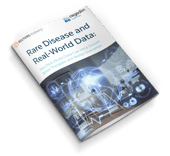Rare diseases: How real-world data can help deliver new therapies

In Europe, 30 million people live with rare diseases, for many of which currently there is no available treatment. Although pharmaceutical companies are continuously working to develop new therapies, the traditional way of conducting randomised clinical trials (RCTs) in the rare disease space is constrained by unique challenges. Large knowledge gaps in the understanding of rare diseases and small population sizes associated with any one of those diseases make designing and conducting trials particularly slow and costly. Yet, for rare disease patients, time is of the essence, while for pharmaceutical companies developing rare disease treatments, excessive RCT costs can mean opportunity costs.
In this article, we provide a comprehensive overview of how real-world data (RWD) and real-world evidence (RWE) in the rare disease space can supplement clinical trials, help design less burdensome trials, advance the creation of common data models, and support regulatory decision-making.
How can RWD and RWE supplement clinical trial data in rare diseases?
For decades, RCTs have been the gold standard for proving the safety and efficacy of investigational products and the sole route to obtaining marketing approval. However, the limitations of clinical trials in the rare disease space – for example, small population sizes that increase patient recruitment difficulties, limit statistical power, and may raise data protection issues – make palpable the need for a complementary approach.
A complementary approach to obtaining rare disease patient data is by interrogating electronic health records (EHRs), clinical databases, patient registries, insurance claims, and other data created in the process of providing medical care. This type of data is known as RWD. RWD sources can create context around patients’ medical histories and provide evidence of the potential benefits or risks of medical products and devices – insights collectively known as RWE.
To date, RWE has been routinely used as part of post-approval safety monitoring of new medicines, but not to demonstrate drug effectiveness in the regulatory approval process. This reality is changing, with the European Medicines Agency (EMA) and the U.S. Food and Drug Administration (FDA) continuously expanding their views on the utility of RWE.
In recent years, both regulators have published a series of guidelines on how trial sponsors can optimise the use of RWE in combination with trial data to support regulatory decisions. Some of the FDA’s guidances cover data sources, data standards, and regulatory considerations.
For its part, the EMA has published guidelines for conducting registry-based studies and outlined its vision for the use of RWE in EU medicines regulations. The United Kingdom’s Medicine and Healthcare products Regulatory Agency (MHRA) has also published guidance on how RWE generated in the course of RCTs can support regulatory decisions.
RWD and RWE: 6 opportunities in rare diseases
- Faster path to demonstrating the viability of novel therapies
One of the most promising opportunities for RWD and RWE in the rare disease space is in helping trial sponsors save costs by making clinical trials more efficient. By leveraging real-world datasets and RWE synthesized from them, researchers can gain new understanding of clinically relevant endpoints faster, reducing the time and costs associated with the R&D process. This also means accelerating time to market and patient access.
- Gathering evidence before clinical development
The first step in researching a new therapy typically involves carrying out a systematic review of the published literature to understand what biomarkers are relevant, what measures to track, or what clinical or patient-reported outcomes (PROs) to look for. However, in rare diseases there may not be many – or any – past studies to learn from.
RWE derived from natural disease history patient records can help address this challenge. Those databases, which may include retrospective patient chart reviews and EHRs, can give researchers important clues, says Alexandre Malouvier, PhD, Senior Director of Innovative Partnerships at ICON, a contract research organisation. “You can do more when you see evidence from primary and secondary care databases.”
- Designing historical control arms and one-arm clinical studies
In clinical trials studying the effectiveness of investigational therapies in small populations, maximising the number of participants in the active arm is essential for increasing statistical power. To that end, study designers can use RWD to build historical control arms, avoiding the need to reduce the number of qualified participants by randomising them.
In the case of rare disease registries that contain longitudinal patient data, RWD can be used to demonstrate how a disease progresses naturally without treatment. “Imagine a registry has been there for 20 years. We know from the data [contained in it] what happens to patients who are not treated with an investigational therapy,” says Prof. Isabelle Durand-Zaleski of the Greater Paris University Hospitals. “When the control group in the study comes from historical RWD, you can compare the natural disease progression against the [progression of] patients treated with the novel therapy.”
- Designing observational studies that may lead to expanding label indications
Another way RWD and RWE can support rare disease research is by enabling observational studies to understand how patients are being prescribed medicines in the real world and if there are any differences between indicated uses and actual prescription patterns. Observational studies are key to assessing the viability of expanding label indications and repurposing approved therapies in an efficient manner, if there is high-quality RWD and RWE that support such expansion.
- Leveraging artificial intelligence (AI) and data analytics to diagnose rare disease patients
In the clinical care setting, AI-powered data analytics can detect patterns in RWD contained in EHRs that can flag patients with a potentially undiagnosed rare disease. In this way, RWD can support clinical decision-making, save physicians time, and reduce frustration for patients in search of a diagnosis. Indirectly, it can also help identify potential participants in clinical trials.
However, to reap the benefits of advanced data analytics, the data pool must be large enough, says Nigel Hughes, Scientific Director at Johnson and Johnson. “From a research point of view, we need large populations to generate signal detections.”
- Partnering with patient experience groups to design less burdensome clinical trials
Clinical trials that put an excessive burden on participants can elevate drop-out and lost-to-follow-up rates. In the context of rare disease trials, which are already struggling with recruiting enough participants, this reduces the probability that a trial reaches the statistical power required to demonstrate efficacy of the product under investigation.
Unfortunately, rare disease researchers rarely have the benefit of learning from past study protocols due to the low number of comparable studies or therapies. Inviting patient input by partnering with patient associations can help remedy that situation.

Rare Diseases Whitepaper
Rare Disease and Real-World Data: How Real-World Data Can Help Deliver Better Therapies and Better Outcomes
3 RWD challenges for pharma aiming to modernise rare disease research
- Developing RWD infrastructure and capabilities
Because RWD and RWE can be used in many ways to inform research, the first challenge is drawing up a research strategy and making sure all relevant internal stakeholders have a say in the process.
For example, Pfizer set up a center of excellence on RWE, which involves experts who can advise on appropriate data sources, as well as Medical Affairs professionals who have a perspective on the type of evidence needed and the unmet medical need.
- Keeping up with rapid developments in RWD
The field of RWD is constantly advancing and it is paramount that pharma companies keep up with changes not only in terms of data types and sources, but also in terms of evolving regulator and payer expectations. Concerns related to data privacy, anonymisation , and managed access add to this challenge.
- Ensuring RWD precision despite variable data protection law interpretations
The European Data Protection Regulation (GDPR) provides important safeguards for data privacy and security, applicable to working with RWD, but the regulation suffers from being interpreted differently by European member states. This creates problems around data capture, quality, consistency, and availability, underscoring the need for a Europe-wide common data model for rare disease data.
“Researchers want to be accurate, but it’s not always possible when amalgamating data,” says Gilles Paubert, Senior Vice President and Global Head of Health Data at Cegedim. “It’s always a balancing act between the precision expected by a researcher and the data protection required by the law.”
5 ways to make optimal use of RWD in rare diseases
- Careful planning and definition of the research question
Although it may be tempting to rely on RWD that is already available to shape a research question, it is identifying the question first and then searching for appropriate data sources is a better strategy. Doing so narrows down what may otherwise be a large volume of only loosely relevant data and may even require researchers to build their own bespoke RWD database.
- Early engagement with patients
To define the research question, it is important to understand what outcomes matter most to patients living with a rare disease. To do so, researchers must engage patients early in the clinical development process, when they can help develop meaningful patient-reported outcomes (PROs) measures against which to assess the value of the investigational therapy.
- Use of technology to alleviate clinician burden
Software and platform-based technology solutions that capture and analyse RWD can enhance not only rare disease research, but also direct patient care. An example of such technology is a solution with the capabilities to flag patients with potentially undiagnosed disease for further exploration or to suggest optimal treatment pathways as part of clinical decision-making.
- Decision-making that “wraps around” technology
Despite the supportive role of technology in advancing rare disease research and patient care, technology is only a tool in the hands of skilled data stewards. Data governance – which determines how real-world data is ‘plugged’ into databases for easy retrieval – is a more important issue. Having qualified team members that can make appropriate data governance decisions is a key element of making optimal use of RWD.
- Choosing the right real-world data partner
Data partners must safeguard trial sponsors’ intellectual property and trade secrets, comply with research timelines, and provide transparency to stakeholders. These principles ensure that pharma companies can fulfill their own obligations to regulators during the submission and approval phases.
“It’s very important that we [serve as] an auditor and can really expand on where the data has been created, for what purpose, and how,” says Paubert.
Why RWD in rare diseases needs a common data model
Rare disease research with RWD in Europe suffers from a lack of harmonisation between databases owned by different institutions, which makes data aggregation difficult. A common data model that combines disparate datasets into a single federated database is the way to go. Because a common data model standardises the data before analysing it, it also improves data quality and consistency.
“The future [of rare disease research] is in patient EHR data, plus genomics and imaging data,” says Paubert, but notes that for these inputs to be analyzed jointly, the data must be properly coded and structured. A common data model ensures just that, facilitating streamlined data gathering.
A federated database consists of multiple interconnected, decentralised, and autonomous databases. Researchers can access data of interest via a single query, which taps into each of the networked databases and yields a composite result.
How is RWD governance evolving to improve decision-making in Europe?
To promote the use of RWE, the EMA has created the Data Analysis and Real-World Interrogation Network (DARWIN EU). The aim of DARWIN EU is to consolidate RWD across the EU, conduct large-scale observational studies, and establish the value of RWE across a spectrum of regulatory use cases.
Further, the EMA, along with other regulatory agencies, is placing an increasing emphasis on the so-called “FAIR” data principles, whereby data should be findable, accessible, interoperable and reusable.
Interested in exploring how your organisation can make the most of RWD and RWE? Click here to download our whitepaper on RWD and rare diseases.



